The first two Zelda games on NES were natural Virtual Console purchases for me. I play through the first game, usually over the course of one or two days, every couple years (on the NES itself, the Gamecube “Collector’s Edition” disc, and sometimes emulated, but now mostly on Virtual Console). The second game was one I never actually beat as a kid (I managed to get to Thunderbird and always died), but it was a game that I would “re-start” again and again since my youth and its original release. I typically never make it beyond the second palace before either getting bored, frustrated, or just moving along to something else as I tend to do with my Gaming A.D.D.™.
I’ve had a save file on my Virtual Console version set right after a completion of the first palace probably since first downloading the game when it came out back in June 2007. Maybe a month or so ago I was showing Andrew the NES setup down in our basement (along with Sesame Street ABC/123, one of the creepiest games of all time, which I will write about at some point when I come out from under the covers), and played through the first palace in Zelda II, yet again, this time on the ol’ cartridge. I was shocked to see that the save file of my childhood friend (“MIKE C.”), was still there on the game, complete with the little Triforce next to the icon to show he had beaten the game. That excitement reminded me of the Virtual Console version upstairs, so I decided to pick the game up again one day and see how far I would get before the same trend of boredom and/or frustration and/or Gaming A.D.D.™ took place.
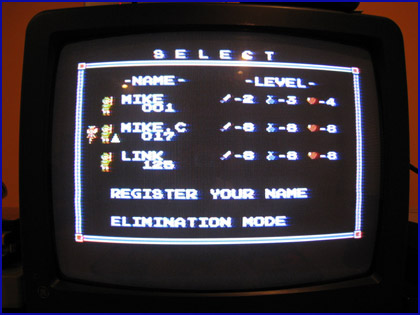
Right now I am in the middle of the third palace (got the raft but have not gone to the boss), and have also ventured over to the eastern continent to save the child, learn two new magic spells, and learn the upward-thrust sword technique. As expected, the most difficult part so far was getting the hammer; if you make it past that point in the game, you are typically going to keep playing for at least a little while longer. With the hammer in tow (and not yet bored), I decided that I would keep playing the game until it frustrated me to the point that it was no longer fun. I especially wanted to get myself over to that eastern continent, something I probably hadn’t seen since I was a kid playing through the game for the first time.
Now that I am there, I find myself asking strange questions… like, do I actually… ya’ know… like this game…?
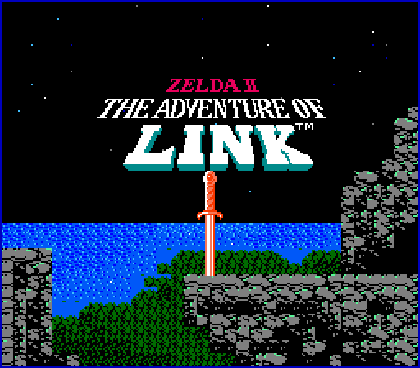
While I had played the first Legend of Zelda rather extensively through trades with friends and rentals, I actually owned my own personal copy of the second game before I owned the first. I was only six years old when it first came out in 1988, and while I do not remember exactly when I got the game, it couldn’t have been all that long after that (maybe within a year?). At that point in a child’s life, they can’t exactly “save up” allowance money to purchase new games or convince their parents to get the latest game, so it was an instance where you (“you” being “I”) got a game and played the ever living Hell out of it, since it was all I had (beyond what I received with the system, which was a collection of Super Mario Bros. / Duck Hunt, Super Mario Bros. 2, and Sesame Street ABC/123, which was more for my sister than me… but, hey…).
But here I am, nearly twenty years after first playing the game. I have barely touched it since then, and yet still remember where everything is located (like jumping down the chimney in Darunia to learn the upward-thrust technique from the swordsman). If I can barely manage to play more than a single palace each time I try to play, do I actually like the game?
Let’s break it down almost review-style —
GAMEPLAY:
One of the criticisms people like to toss at Zelda II is that it plays so differently from the other games. I have seen the following response before, but I think it makes a whole lot of sense — there had only been one game so far, so how on Earth do you compare it to “all” the “other” games? Of course, this is a perspective being taken years later looking back on the game, but for the time, it seemed like a natural extension of the gameplay seen in the first game. You are still Link with a sword and shield; you are still wandering around a massive world free to go anywhere you want with the items available to you so far; you unlock new areas to explore with new items; you can venture in and out of levels/palaces without finishing them if you really want to; etc. Of course, the concepts of experience points, magic, and especially “lives” were incredibly different from the first game, but again… for the time, it seemed like a logical expansion on the original. Another point I have seen many times before is that the side-scrolling sections in Link’s Awakening appear to be nods to Zelda II, even with their Mario-enemy cameos; they feel like single-screen Zelda II palaces with elevators, jumps, and especially the “Skull” enemy (itself reminiscent of the “Bubble” foes from the first game’s dungeons).
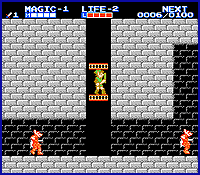
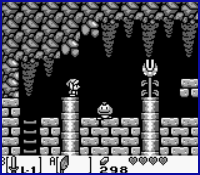
(Link’s Awakening shot from gamespite.net)
This is still all hindsight, though. How about the controls, as in how Link actually moves and responds to you…? Back then and today I still feel that Link moves realistically and reacts appropriately for who he is. Quite frankly, once you obtain the downward-thrust sword technique, pro players can make Link look almost graceful in the way he hops and bounces off of foes, acting like a skipping-stone through caves and palace corridors.

Link’s jumping ability in Ocarina of Time seems to be an exact copy of his Zelda II technique, albeit no longer manually-controlled. Unlike Mario, Link does not and cannot jump three or four times his own height. There is a certain “weight” to him that grounds him in reality, no matter how unrealistic and fantastic the scenario is. It still feels a little “stiff” like many of the early NES games, but was a clear mid-way point between the first generation of games and the masterpieces of technological wonder that were the system’s swan songs.
GRAPHICS:
While the first game by no means features an overly-saturated, lush landscape… the second game does feel like it has a more subdued, muted color palette. With the exception of the green forests and grass on the overworld, this section of Hyrule seems to be a rather dull place.
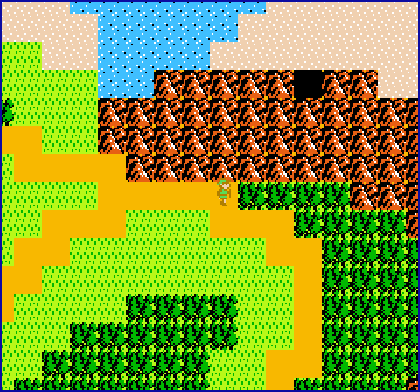
Palaces are entirely single-color, caves are either dark or lit up in orange… heck, the most colorful things in the game are probably the enemies! This may have been a conscious decision to set them apart from their backgrounds, now that I step back to look at it more closely. Even Link’s outfit is a somewhat-desaturated version of what we (now) traditionally think of as his green tunic when placed upon the various backgrounds. Sure, it was partially a limitation of the console and the number of colors it can display, but it all comes together to form “Link” in a very special way.
![]()
The game absolutely has its own aesthetic, one that was later used as “inspiration” for plenty of other games. The overworld was sparse and its enemy icons looked ridiculous, and as mentioned the colors were somewhat dull… but at the time, nothing else looked like it. Even today, it retains its own individual look, and one that seems to have been referenced and expanded upon in style by games like Ocarina of Time.
MUSIC:
Despite the score being composed by Akito Nakatsuka (rather than veteran Koji Kondo), few people will claim that Zelda II has “bad” music. While the first game’s main melody is only briefly hinted at with the beginning of the overworld theme, this approach would return with Ocarina of Time… and it seemed to work out pretty OK there, too. The true testament to Zelda II‘s score is the inclusion of the palace music in Super Smash Bros. Melee, and a medley of the normal and final palace songs in Brawl. This one haunting piece seems to have survived the test of time more so than any other element from the game, and for good reason. Folks tend to overlook the rest of the game’s score, however; the town music laid the groundwork for later songs like the Kakariko Village theme in its simplicity and tone, while the cave music got you on the edge of your seat in anticipation of whether or not another Daria was going to come swinging with some flying axes.
Needless to say, the score is phenomenal, and near-universally enjoyed. It contributes quite a bit to the overall enjoyment of the game.
DIFFICULTY:
This is not an easy game. Even as an NES-generation child, I could not defeat Thunderbird in the final palace. Perhaps the first clue you get about the game’s difficulty is when you wander into the northern desert cave before getting the candle; if you somehow manage to jump past the bats and fire pits, that Goriya is nailing you with his boomerang.
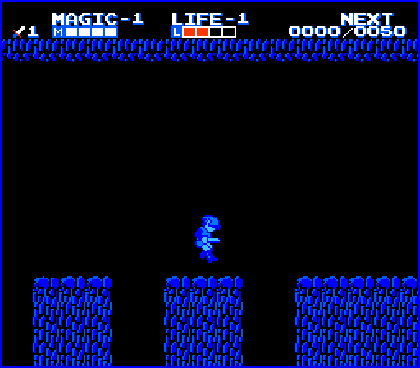
As I mentioned earlier, the true test of might is simply obtaining the hammer sometime after beating the first palace. If you can make your way past that one, final, red Daria… chances are you have the chops to continue. Even after that, though, the game does not hold back. The Ironknuckles are particularly difficult to deal with if you do not play defensively (something you rarely had to do in the first game), and choosing the wrong path in the third palace without first confronting that blue Ironknuckle trapped inside the blocks means you’re going to be battling a red one in front of you while the blue one throws knives at you from behind. Hitting a little, floating bubble while jumping across a pit invariably means you are falling to your death. Not grinding up a little magic-meter extension means you probably will not have enough magic points to cast that “Life” or even “Shield” spell when confronting the palace boss.
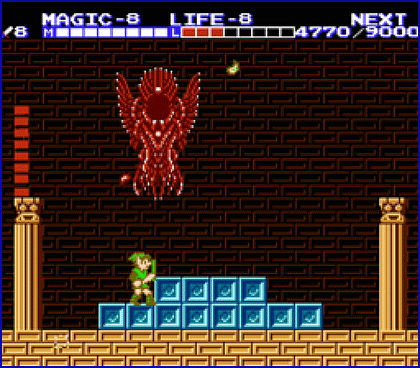
The game is unforgiving, but mostly fair. Some of the enemies move rather unpredictably, and the Mace Thrower can be difficult to get some inside-range on, but perseverance means you will ultimately learn the general gameplay patterns and move forward.
LEVEL DESIGN:
I have recently been playing through Retro Game Challenge on the DS. The final game, Robot Ninja Haggle Man 3, is a game in the vein of something like Metroid mashed up with some later Castlevania and a little old-school Ninja Gaiden or Shinobi; you are free to explore the world in the standard side-scrolling, action-game view with your sword, shuriken, jumps, etc. You can upgrade your abilities by purchasing “gears”, which grant you higher jumps, floating, powered-up shuriken blasts, and more. I have only barely played a couple minutes into the first Metroid game, and I have only played Castlevania games pre-Symphony of the Night. I have relatively little experience in the open-world “Metroidvania” style of games, and yet I find myself absolutely in love. There is no doubt in my mind that my PS3 & PSP will soon have a copy of Symphony of the Night on them, and I am even more excited to play Super Metroid.
How does this all relate to Zelda II, though?
You could make a somewhat-solid argument that Zelda II falls in line with this style of game. In fact, Jeremy Parish has done so. The palaces in Zelda II have some degree of “open-world” to them, albeit on a much smaller scale. The “standard” (again, only the second game here…) Zelda tropes of keys to open locked doors remain in your path, but upgraded magic spells like “Jump” and the glove which allows you to break blocks are what lead you to new areas in these palaces. Again, you are free to wander in and out of palaces as you choose; if all you want to do is grab that palace’s special item and move on without defeating the boss, feel free (similar to how you can play the first game). You will eventually have to come back to defeat him to place the crystal at the end of the level if you want to open up the final palace, but it is all left up to you to decide how and in what kind of order.

(palace map from nesmaps.com)
In this respect, Zelda II almost seems like a “Metroidvania LITE” gameplay experience. Perhaps it acting as the basis for any familiarity I have with that type of gameplay and level design is what now has me interested in going back and checking out some of these major hits that I somehow missed over the years.
HILARITY:
Who can forget “I AM ERROR.“…? Even when accurate to the original Japanese script (as Error was), the half-translated nature of the game combined with the lack of character space to get across the necessary information certainly led to an unparalleled experience. Between Link actually “speaking” aloud for what may be the only time in the franchise’s history (“I FOUND A MIRROR UNDER THE TABLE.“), the in-retrospect pondering about what exactly goes on inside that lady’s house when Link’s health is restored, and the oft-seen “GAME OVER RETURN OF GANON” (brought about by sprinkling your blood on the big boss’ remains, mind you)… few games come close to the written-text experience of Zelda II.
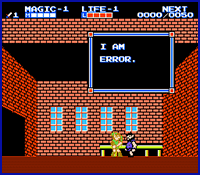
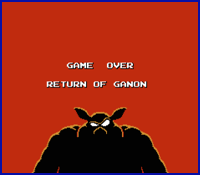
SO DO I LIKE THE DARN THING?!
That’s a tough call. It is incredibly difficult to look back on your own personal history and familiarity with something and try to understand if you genuinely like it, or only think you like it due to that familiarity. Then again, if I am able to look back on things like He-Man and wonder how on Earth I ever liked it, I suppose I could do the same with video games and take a slightly-more objective look.
With that in mind, I think I do like Zelda II. I like it more than just a historical snapshot in a series that contains two of my favorite games of all-time (the original and Link’s Awakening), but I also appreciate it on that level of timely-significance. I like it more than just a piece of my childhood gaming adventures. I appreciate many of the artistic choices made in its development. The level design continues to intrigue me. The enemies become more and more frightening as the game progresses, certainly keeping me on the edge of my seat. The game is difficult, but not impossible (Hello, there, other game from my youth called Battletoads), which provides an incredible sense of accomplishment.
It is constantly called the “black sheep” of the franchise (typically with Majora’s Mask not far behind), but this should not be taken pejoratively. Many of its elements have stood the test of time to resurface in other games (the temple music, Dark Link), proving their historical significance and underlying genius. The fact that the game itself has been re-released an appropriate, but not overwhelming, number of times (GBA, Gamecube “Collector’s Edition” disc, Virtual Console) also speaks volumes.
Zelda II is a good game… it might even be great. I think I like it.


I never beat Zelda II either. I always find myself picking it up every now and then too.
Sometimes franchises characters will cloud your judgment because you usually have an emotional attachment to them. So when I don’t know if I like a game or not I always try to picture different characters. Like would you play Mario Sunshine if it didn’t have Mario but instead a wallabie and he had to save his kangaroo girlfriend? I wouldn’t, which makes me clearly know that I hate Mario Sunshine. But if you could still play it with different characters then yea, it’s a good game. I’m not saying do this to all games, but if you have to think about if you like a game or not, it’s not a bad idea.
So if Link II had different characters… if it had some girl trying to save her boyfriend? I think I would still play it. It still seems fun challenging years after it’s release. I would maybe get sick of playing quicker but I’d still be playing it.
This is kind of how I feel about the game, but given that I’m about ten years younger than you, I didn’t actually play the game until… Maybe five years ago?
I’ll try to play it every once in a while, but never really get past the first palace.
I have no issues with the fact that it plays differently. I do, however, get this “sick” feeling when I do sit down with it. Maybe it’s the color scheme or the character designs, or something.
I have made it farther in “Zelda II” than I have in the original, though, I’m sad to say. Haha… 😛
I often wonder the same thing myself, because I definitely have a love-hate relationship with Zelda II. It’s an incredibly frustrating game at times, but it also has a lot of quirks that make it lovable and even fun.
My cartridge had this bizarre issue where it would freeze up during the Thunderbird fight (it was used, so who knows what someone did to it), so I was never able to beat it until I got the Collector’s Edition disc for Gamecube years later. Now that I have a Wii, I’m probably going to buy it for VC soon, and I both look forward to and dread trying to beat it again.
I never played Zelda 2, but that downward thrust is my go to link move in smash brothers, so I really appreciate this game :-P.